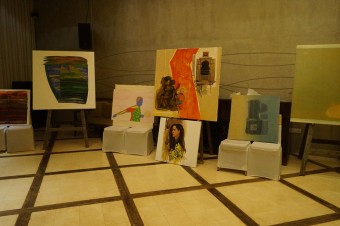Photographs by Daryl Andrade
.
.
In recent years, pill the works of painters like Tyeb Mehta, health Syed Hyder Raza and Goa’s own Francis Newton Souza have been sold for millions of dollars. Just before the recession crashed in, here Souza’s painting titled ‘Birth’ sold for over 2.5 million dollars at a Christie’s auction in 2008. Two years later the art market bounced back in style, and Raza’s acrylic on canvas Saurashtra went under the hammer in 2010 for 3.5 million!
Who are the millionaires buying these works? Many of them are private art buyers who speculate in art, much as stock traders work the market. What is the code by which these mysterious merchants of the art operate? Durva Gandhi promises to reveal all in her new book Secrets of the Art Millionaires. She was in conversation with Anil Dharker, writer and columnist, at the Sunaparanta Center for the Arts in Panjim on Saturday 16th March, where her book was launched. Durva Gandhi is an art collector, publisher, curator and founder of the art portal breathearts.com. She has also been one of the youngest members on the executive committee of the Friends of the NGMA?National Gallery of Modern Arts.
.
.
Here are excerpts from the Gandhi-Dharker conversation:
ANIL DHARKER: There are problems in the art market, not enough art buyers. In the art market there are always the same set of faces. How does one bring in more people?
DURVA GANDHI: The market has to be made more inclusive, we have to spread the aesthetic. We must spread awareness of what to buy and how to buy. The way it is now, a small market, that’s due to the attitudes of galleries. Most people are intimidated by galleries. People also want to engage with art, not just buy. We have to make them aware of the market, share our mistakes and experience. Events like art openings and launches don’t go beyond a superficial point. The art market needs deeper insight and a holistic understanding.
AD: But art has always been elitist, Aesthetics is not easy to understand. The availability of art is also limited to those who can afford it. How do you bring in more people?
DG: We must understand the motivations of the individual, whether he is a buyer or seller or an investor or an artist.
AD: So what does the new buyer do to start?
DG: A lot of research. Go to galleries, find out who are their top 3 artists, what is the current trend. Find out about the primary and secondary markets for these works. Attend gallery openings, art auctions and exhibitions, talk to curators and find out who are their top artists.
AD: But how approachable is the artist or a gallery? Can an artist just walk up to Anjolie Ela Menon and talk to her?
DG: That’s the role of the gallery. The gallery has to take the buyer through the range of Menon. The motivation of the buyer varies?he may want to only collect art, that’s a different vision. If he wants to invest in art and make millions, that’s a different strategy.
AD: But a new art buyer doesn’t see all that. He or she just wants to buy the painting, decorate their apartment with it, and hope it increases in value.
DG: Yes, he starts buying, then he buys more, then he stores it away, he buys a new house to store his collection?he begins to see it as an asset. The role of the gallery is to define this vision. Else you will end up with a pile of art that you didn’t really want, that is worthless!
AD: But again, how does the buyer sense good art? Take Dodiya. She doesn’t do ‘pretty’ art, she takes photos and twists them around…at first look the works would appear very banal. Anjolie Menon’s art is beautiful to look at. But Dodiya sells better than Anjolie. How does the new buyer distinguish this?
DG: You need a sense of how strongly the promoter feels about the artist. What is behind the hype? What do the critics say?
AD: There are no critics today. The media has very few critics. If a gallery promotes some works and their intrinsic value may not be high, there are no critics to say this is rubbish…The new buyer doesn’t know, he is not an insider.
DG: Then he has to become an insider. Ask 5 top stakeholders about the artist’s potential. Read the artist’s profile at the end of the catalogue. Find out if he or she is being shown only at random galleries. You have to get a sense of where he is showing, get a pulse…
AD: So I must first know which are the top galleries?
DG: Yes, you must know the top 5 galleries, critics and auction houses. You must know the influences that move trends. Buying takes place on the upward movement of an artist’s value, or at his peak, or on the downward slide. One shouldn’t buy when it is too late. The work must be bought when the artist’s career and value is on an upward trend. In 1995 you could buy a Hussain or Raza for 2 lakhs rupees. Today if you buy those works for 2 million dollars you don’t know which way the trend will go.
AD: Could you specifically name 5 top artists to buy?
DG: Manjit Bawa, Sabawala, Anju Dodiya, Manjunath Kamath, Ravinder Reddy…There could be steep rises and falls in the art market. Anything that goes up comes down.
AD: So should we look at the painting only as a trade asset? We should not fall in love with a painting that we own?
DG: Different persons have different motivations?are you a collector or an investor? Again, there are some works you keep, you find a niche, a kind or series of paintings and you create a hoard of those works. The other works, you sell. When you set out to buy, anything under two lakhs is a good place to start. Get a sense of other people’s views. Find five stakeholders ? critics, curators, gallery owners ? and see if at least three of them agree on your choice of work. Don’t start with overconfidence and without research.
.
Secrets of the Art Millionaires is available online at www.amazon.com and at www.breathearts.com
..
.
.
.





